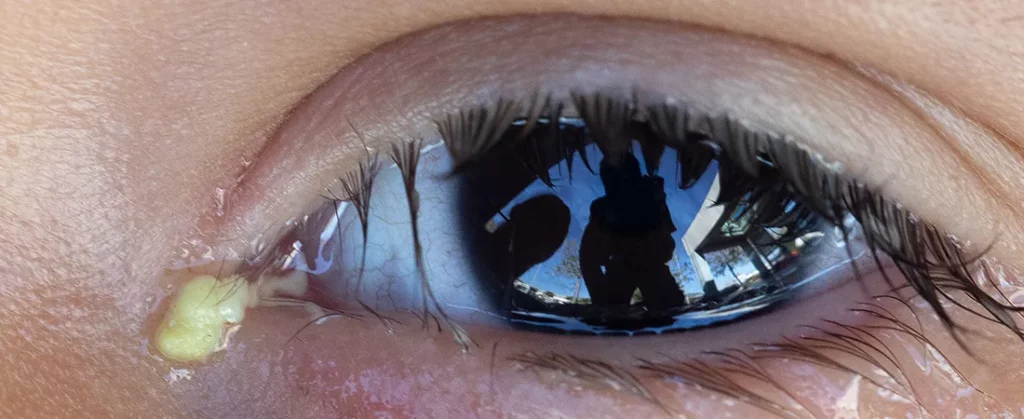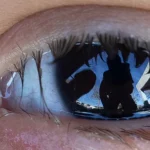Eye discharge, often called “eye mucus” or “sleep in your eyes,” is a common occurrence that most people experience daily. It is the sticky fluid or crusty residue that collects in the corners of the eyes, particularly upon waking. While normal amounts of discharge are harmless, excessive or abnormal discharge may signal an underlying issue that requires medical attention.
At Centre for Sight, we prioritise educating patients about eye discharge, including its causes, types, and the most effective ways to manage it.
What is Eye Discharge?
Eye discharge is a combination of mucus, oil, skin cells, and other debris that accumulates in the corners of your eyes. It is produced by the conjunctiva (the thin membrane lining the eyelids) and the meibomian glands (oil glands in the eyelids). This fluid plays an essential role in maintaining eye health by trapping debris and keeping the eyes lubricated.
However, when there is excess eye discharge, changes in colour or consistency, or is accompanied by other symptoms, it may indicate an eye condition.
Types of Eye Discharge
The colour and consistency of eye discharge can provide clues about the underlying issue:
- Whitish Discharge from Eyes: Often associated with allergies, dry eye, or viral conjunctivitis.
- Yellow Discharge from Eyes: A sign of bacterial infection, such as conjunctivitis or a stye.
- Green Discharge: Indicates a more severe bacterial infection and requires immediate medical attention.
What is the Reason for Eye Discharge?
There are several reasons for eye discharge, ranging from benign causes to more serious underlying conditions:
Conjunctivitis (Pink Eye)
- Viral conjunctivitis typically produces watery or sticky discharge, while bacterial conjunctivitis causes thick yellow or green discharge.
Blepharitis
- Inflammation of the eyelids can cause sticky crusty eyes.
- This condition is often accompanied by redness and itching.
Dry Eye Syndrome
Insufficient tear production can lead to the accumulation of mucus, resulting in sticky eyes in the morning.
Allergies
- Seasonal or environmental allergies can trigger watery eyes with a whitish discharge from eyes, especially after rubbing them.
Eye Infections
- Conditions like corneal ulcers or styes may result in localised yellow discharge from eye.
Blocked Tear Ducts
- A blockage in the tear drainage system can cause a build-up of tears and mucus, leading to crusty eyes or persistent discharge.
Contact Lens-Related Issues
- Poor lens hygiene or overwearing contacts can lead to irritation and excess eye discharge, often accompanied by redness and discomfort.
Treatment for Eye Discharge
Medications and Eye Drops
- Lubricating Eye Drops: Ideal for managing dryness-related sticky eyes in the morning or mild irritation.
- Antibiotic Drops or Ointments: Prescribed for bacterial conjunctivitis or styes to eliminate infection.
- Antihistamine Drops: Used to treat allergies that result in whitish discharge from eyes or watery eyes.
Treating Underlying Conditions
If the discharge is caused by conditions like blepharitis, conjunctivitis, or a blocked tear duct, targeted treatments such as medication or minor procedures may be necessary.
Home Remedies for Eye Discharge
For mild cases of eye discharge, simple home remedies can provide relief and prevent worsening symptoms:
Gentle Cleaning
Use a clean, damp cloth or cotton ball to wipe away the discharge gently. Ensure you use a fresh cloth for each eye to avoid cross-contamination.
Warm Compress
A warm compress can help soothe irritation and loosen the crusty residue.
Use Artificial Tears
Lubricating eye drops can help flush out debris and maintain moisture in the eyes.
Avoid Allergens and Irritants
Minimise exposure to pollen, dust, or other allergens that may trigger excessive tearing or whitish discharge from eyes.
Rest Your Eyes
Limit screen time and ensure adequate sleep to reduce eye strain and irritation.
When to See an Eye Specialist?
While mild eye discharge is normal, certain signs warrant immediate medical attention:
- Persistent or worsening sticky crusty eyes.
- Green or yellow discharge accompanied by redness and swelling.
- Blurred vision or sensitivity to light.
- Pain or discomfort in the eyes.
At Centre for Sight, our team of experienced eye specialists can diagnose and treat the root cause of your eye discharge, ensuring long-term relief and improved eye health.
Take the first step toward healthier, more beautiful eyes Book an Appointment with Centre for Sight in India!
Frequently Asked Questions
Eye discharge occurs due to mucus, oil, and debris. Common causes include allergies, infections like conjunctivitis, dry eye syndrome, or blocked tear ducts.
Clean your eyes gently with a damp cloth, apply a warm compress, and use lubricating eye drops. For persistent or severe discharge, consult an eye specialist for appropriate treatment.
Excess mucus in the eye can result from infections, blocked tear ducts, or irritation caused by allergens, dryness, or contact lens misuse.
The discharge that forms in the corners of your eyes overnight is commonly called “eye crust” or “sleep in your eyes.” It’s a normal process that helps remove debris during sleep.





